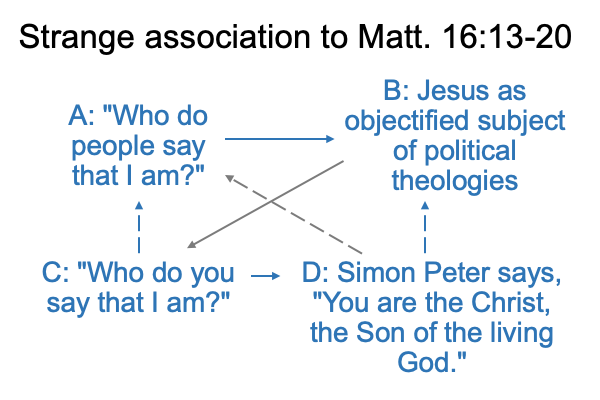0026 What goes into D?
Once again, consider the strange association to Matthew 16:13-20.
Here is the complete Greimas square.

0027 D contrasts with C, contradicts A and complements B.
The contrast between D and C is clear. C is a question. D is an answer.
The contradiction between D and A is less obvious. What Peter says is not the same as who people say that Jesus is. Yet, it is the same. People intuitively feel Simon Peter’s answer, yet cannot say, because they fear the Pharisees and Sadducees. They fear those who frame the political theologies of the day. Their angst is existential.
The complement between D and B is difficult to fathom. Perhaps, the experts of Jerusalem may be able to formulate the theology of Christ as the Son of the living God (B). But, they cannot recognize Jesus as the person who fulfills theological expectations (D). The inability to recognize Jesus is existential.
0028 So, how does the complement between D and B work?
How does fulfillment (D) implicate contemporary models of the anticipated phenomena of the Christ, Son of the living God (B).
Jesus cannot be the Messiah because Jesus is not the one who fits our models.
0029 Christian theologians take note.
Dugin’s fourth political theory may be what you should be exploring.
Who defines who Jesus is?
The experts or the uncertified fisherman?
0030 To me, the complement between D and B parallels the way that a noumenon and its phenomena complement one another. The noumenon is the thing itself. Its phenomena are its observable and measurable facets. A noumenon cannot be objectified as its phenomena.
This is one of the weird (and often not discussed) features of modern science. Every scientist works to observe and model and talk about phenomena. But, no scientist can address the noumenon, the thing itself.
But, the narod (C) is the noumenon. So, (D) must be some transit between the noumenon (C) and its phenomena (B).
Yes, Dugin’s Greimas square goes one step further.
Dugin introduces the term, “ethnos”, as that which is prior to the narod. Ethnos is where the narod comes from and where the narod cannot return to.
Here is a picture of the ethnos in its placement in Dugin’s Greimas square.

0031 Now I replace the term, “ethnos” with “cannot be objectified as” in order to elucidate a resonance.
“Cannot be objectified as” (D) is where the noumenon (C) comes from and where the noumenon (C) cannot return to. Plus, it (D) is a transit between a noumenon (C) and its phenomena (B). It (D) consists of a contradiction that exists in the realm of potential. What something is cannot be objectified as what scientists observe and measure.
“Cannot be objectified as” expresses an impossibility. Yet, here is the foundation of science.
